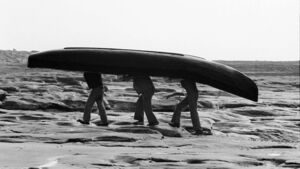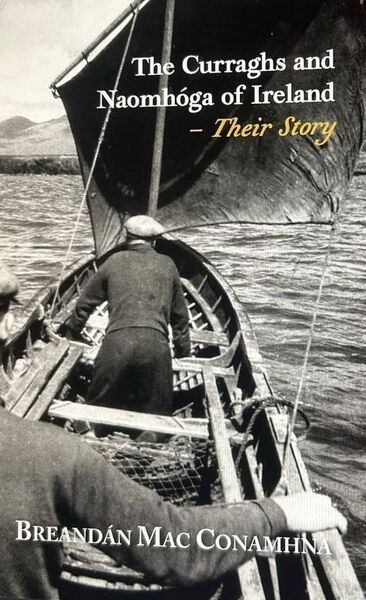New book recalls heyday of currach fishing in West

Carrying currach on Inishmaan (1988)
The currach was an invaluable lifeline to generations of fishing communities on the West coast, according to a retired Belderrig academic who has a long-held love of the traditional vessel.
Author Breandán Mac Conamhna (Brendan Caulfield) launched his latest book last week. The 89-year-old’s book, entitled , was launched in the Erris Coast Hotel Geesala on Friday last. The book is published by Mayo Books Press.
“I have been fascinated by currachs since I was a barefoot gasur in Belderrig,” said Breandán, who previously penned a book on the unique Belderrig Currach, having grown up in the North Mayo village during the 1940s.
“The salmon fishing at that time lasted from mid-June to the second week in August. At that time, 50 men in 10 currachs put to sea every evening. I was down with the currachs like every other boy in the village every evening they were going out and became fascinated with them.”
Breandán said the currach’s significance to life on the west coast cannot be overlooked. There was a very vibrant fishing industry along the western seaboard and it kept many communities alive. The humble currach was key to the survival of the fishing industry.
“Later on in life I began to appreciate how significant and important the currach was for the very poor population that lived on the west coast of Ireland. The currach was the main fishing vessel on the west coast from 1850 to 1960. At its height there were something between 1,500 to 2,000 fishing currachs on that stretch of coast. There were no more than 400 fishing row boats and sail boats at the time.
“The currach was by far the most important fishing vessel on the coast. It fed the people who lived on that coast. Fishermen generally had four to five acres of land for which they paid an exorbitant rent in the early years to greedy landlords and the currach fed them. It provided food all year around,” said Breandán.

He said the currach helped local people prosper and avoid a life of abject poverty. This was especially the case in the early 1940s when employment opportunities in the West of Ireland were extremely limited and many men did not want to emigrate to England because of World War II. The fishing industry was thriving in North Mayo in the mid-twentieth century when Breandán was growing up in Belderrig.
“In 1950, 50 men were fishing out of Belderrig. The average share was £100 per man. Just think about how important that was in those days. A one-year old hogget would go for about £30 so the farm incomes on the tiny holding that they had were something like £50 to £80 at the time and they earned £100 in the six weeks of the salmon season. That was an enormous contribution to their income," he remarks. "My father was a school teacher and principal. In 1950 he earned £170 as a principal. So 50 fishermen in Belderrig with the fishing and farming were earning as much as a school teacher.
"That happened all along the coast and it had a major significance for the quality of life for people on the coast of Ireland.”
Breandán also recalled the huge mackerel catches that would come ashore at the pier in Belderrig.
“Heaps and heaps of mackerel. I have so many wonderful memories of the currach. Since I retired I have been studying currachs."
He has vivid memories of the highly competitive currach boat races.
“The last currach race I helped to organise, believe it or not in 1953, ended in a massive brawl as currach races all over the coast always did!" he recalls, laughing.
Breandán was born and reared in Belderrig in the Erris Gaeltacht. For the last 40 years he has lived in Riverstown, Co Sligo. He taught and lectured for 20 years in the United Kingdom before being appointed principal of the then Regional Technical College in Sligo in 1980. Breandán later served as Director of the Institute of Technology, Sligo. He retired in 2001 and this his fourth book to be published.
Breandán also helped to build three currachs which are regularly displayed at maritime festivals in France.
In addition to his latest book, later this year a special work entitled , which is written in the Erris dialect of Irish, will be published. This will be the first book in decades to be written in that dialect.
is available in all local bookshops in Mayo and online from www.mayobooks.ie.






